Speech The Ongoing Evolution of the Australian Payments System
Today's conference is on payments innovation and I would like to speak about some ways that our payments system is evolving, both in terms of some innovative new payment instruments that are on their way and the declining use of some of our older or legacy payment instruments. I will also provide a short update on the Bank's current Review of Card Payments Regulation.
The Cheque System
The first topic involves an instrument – the cheque – that is being used less frequently now, but which raises sensitive issues for both the payments industry and the broader community.
My first graph is a familiar one showing the number of non-cash payments per capita per year in Australia. It clearly demonstrates the steady growth of various forms of electronic payments and the decline in the use of cheques. The number of cheques written in Australia has declined from around 50 per capita per year in the mid‑1990s to about six cheques per capita in 2015.
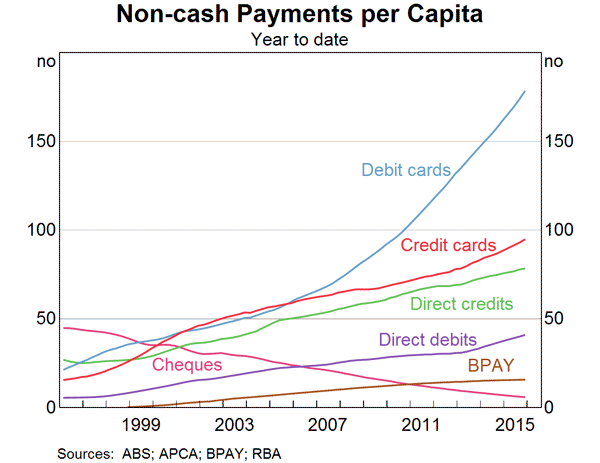
There is a long-term decline occurring in the use of all types of cheques – financial institution or bank cheques, personal cheques, and commercial cheques (that is, cheques written by businesses and government entities). Moreover, the decline is accelerating. One can see that by comparing the average decline in the most recent five-year period (13½ per cent) relative to the previous one (10 per cent). Indeed, most recently cheque usage has been declining at a rate of about 16 per cent per annum.
| Average Annual Growth (per cent) | |||||
|---|---|---|---|---|---|
| 1995-2005 | 2005–2015 | 2005-2010 | 2010-2015 | ||
| Commercial | – | −12.1 | −9.8 | −14.3 | |
| Financial Institution | – | −6.8 | −7.6 | −6.0 | |
| Personal | – | −11.8 | −10.1 | −13.5 | |
| Total | −5.0 | −11.7 | −9.8 | −13.5 | |
|
Source: RBA |
|||||
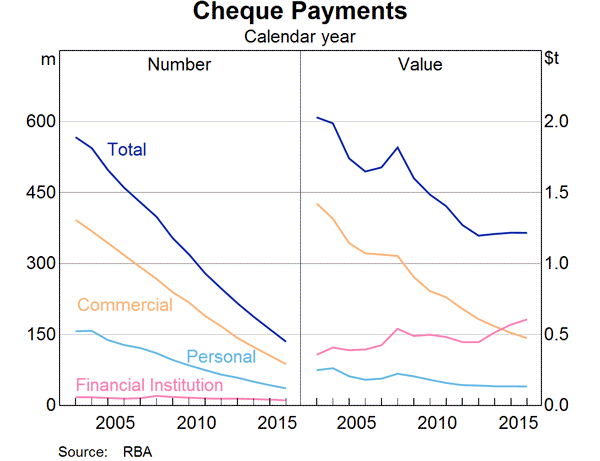
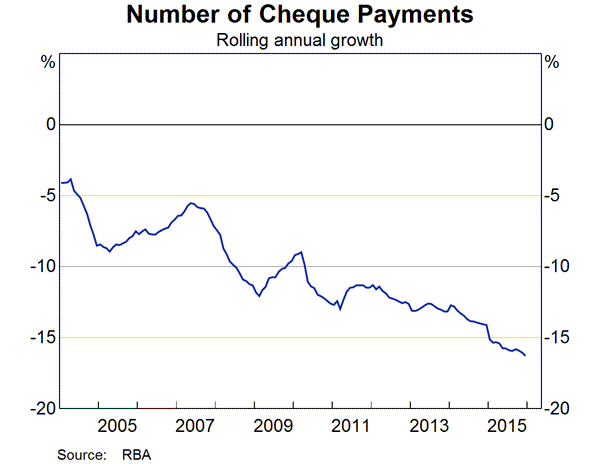
The decline in cheque usage is a global phenomenon. All the OECD countries for which consistent payments data are available show declines of 45 per cent or more in per capita usage over 2000–2014. In six of those countries, admittedly ones where usage was already quite low, cheques have essentially disappeared. In at least one case – the Netherlands – the system has been closed.
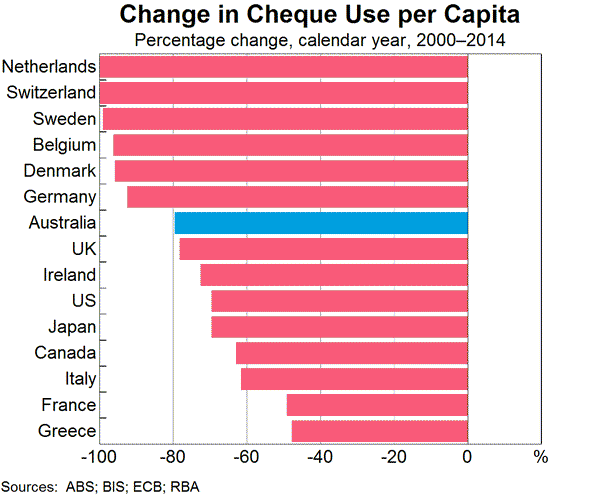
But the decline in cheque usage in Australia is a bit larger than the overall decline for OECD economies. So our cheque usage is now quite low compared with most other English-speaking economies.
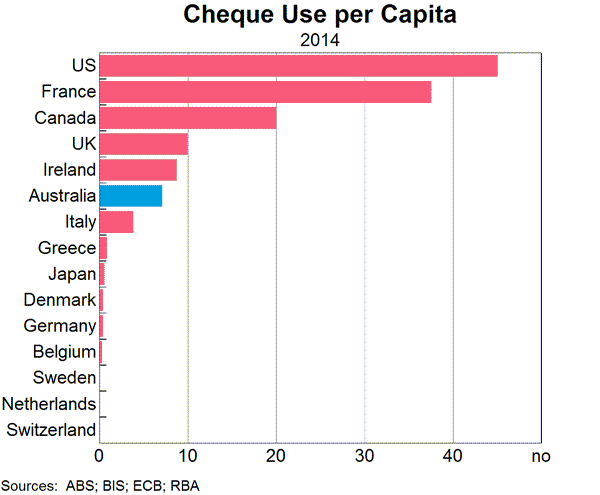
Data from the Bank's Payment Cost Study show that cheques are a relatively expensive payment instrument in terms of the resource costs incurred by financial institutions and merchants in accepting payments from households.
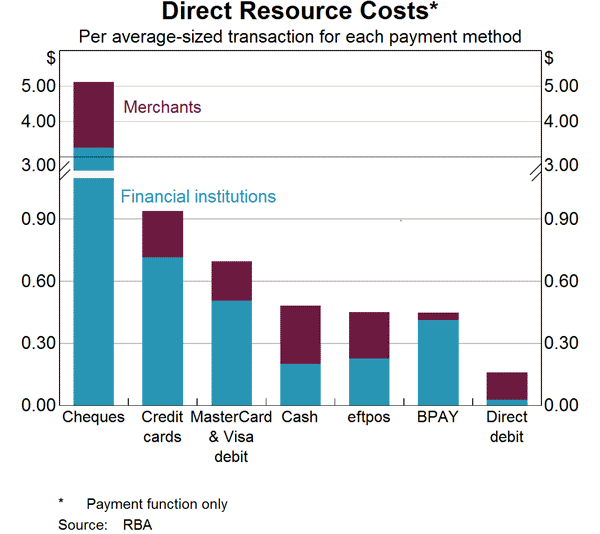
Based on this, one might expect to see bank customers paying significant amounts to use cheques. That is true in the case of bank cheques, where demand is often not especially price elastic. But it does not appear to be the case for most other types of cheques. Business and government customers generally pay to write or receive cheques, but charges are typically less than the average cost suggested by this graph. And personal customers typically don't pay to write or receive cheques. Or rather, they do so indirectly via their interest margin and any account-keeping fees.
The ongoing decline in cheque use and the prospect of increases in unit costs raise the question of whether the industry should be doing anything to actively manage the decline of the cheque system. This issue was first addressed in a 2011 consultation by the Australian Payments Clearing Association (APCA) which was entitled ‘The Role of Cheques in an Evolving Payments System’.
In the 2012 report that followed, APCA concluded that there was ‘no immediate need to consider closing the cheque system’ and that the future of cheques could be primarily addressed through the operation of market forces. However, it noted that declining cheque volumes would see unit costs rise for cheque providers, so it was likely that costs to users would rise. In addition, it said that users would also find it increasingly difficult to make or receive payments by cheque as use declined more generally. It also noted that cheque use remained concentrated within particular demographic groups and industry segments and that those groups faced certain barriers in moving away from cheques. It suggested a range of initiatives, including helping cheque users to switch to electronic alternatives.
Since APCA made that judgment in May 2012, the overall number of cheques written has fallen by a further 40 per cent or more. But it is noteworthy that the decline in the use of cheques over this period has not been accompanied by any significant concern from users about difficulties in making or receiving payments by cheque. Instead, it has been quite orderly and appears to have simply reflected consumers, businesses and government entities switching to other, newer payment methods that better meet their needs.
With the establishment of the Australian Payments Council in 2014, the industry is again starting to focus again on the future of the cheque system. The Council's Australian Payments Plan, which was released in December 2015, contains three themes, one of which is called ‘Managing Australia's Payments Mix’. This theme includes an initiative to manage the transition away from cheques:
As payment habits and processes become more digital and cheques continue to decline and become harder and more costly to use, there will be a requirement to transition cheques to more efficient and sustainable payment methods. Our initiative will deliver a collaborative approach to ensuring more convenient payment choices are made available to all users of the payment system, prior to the identification of an end date for cheques.
That is, the industry's expectation is that cheques should be phased out at some point, but only when it is clear that the needs of current cheque users can be met by other payment methods.
In thinking about this issue, the industry will no doubt be mindful of the experience in the United Kingdom. In 2009, the UK Payments Council announced that cheques would be phased out by 2018 if adequate alternatives had been developed. Even though this decision was made after a lengthy consultation and was conditional on the development of alternative payment methods, it was unpopular with consumers and small businesses and was subsequently reversed in 2011.
While this is a cautionary tale, it may be worth noting that the decline in the use of cheques in Australia is now much further advanced than it was when this issue was considered in the United Kingdom.
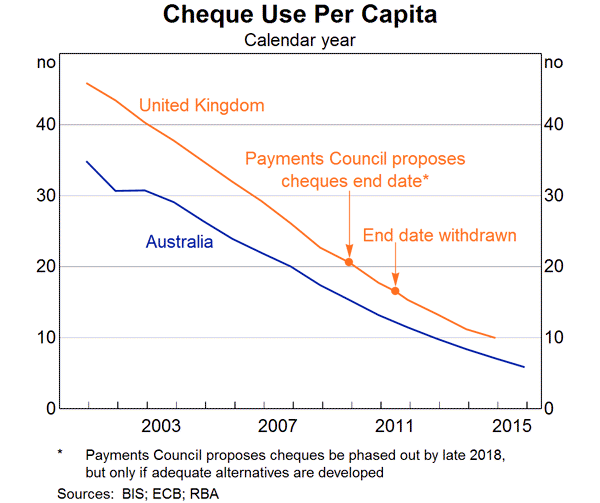
There is a lot happening in the payments industry at present, so my sense is that it would be premature to have a serious discussion about possibly phasing out cheques before the implementation of the New Payments Platform (NPP), which is scheduled to begin operations in late 2017. But if this conference was to revisit this issue in early 2018 with the NPP up and running, it should find significant new payments functionality in place. This will include the ability for end-users to make real-time transfers with immediate availability of funds, to make such transfers on a 24/7 basis, to attach data or documents with payments or payment requests, and to send funds without knowing the recipient's BSB and account number. These are all aspects that match or exceed particular attributes of cheques.
In addition, by early 2018 another two years will have passed and there will no doubt have been a significant further decline – based on current trends, a further 30 per cent or so – in cheque usage.
By that point, more organisations and individuals will have further reduced their cheque usage. The Bank has recently been doing some liaison with payment system end-users in our Payments Consultation Group and has heard some impressive accounts about how some of the major Commonwealth government departments and some large corporates have largely moved away from the use of cheques. Cheque usage in the superannuation industry has also fallen very significantly as part of the SuperStream reforms.
A shift away from the use of bank cheques is also underway in property settlements. On average, there are around 40 000 property transactions in Australia each month, plus a significant number of refinancings, with most of these requiring at least a couple of cheques for settlement. However, starting in late 2014 and after much preparatory work, electronic conveyancing and settlement is now feasible. This is being arranged by Property Exchange Australia Ltd (an initiative that includes several state governments and a number of financial institutions), with interbank settlement occurring in RITS, the Reserve Bank's real-time gross settlement system. Volumes have risen steadily and by late 2015 the number of property batches settled in RITS – each batch typically corresponds to a single transaction or refinancing – had reached nearly 4 000 per month. This trend is expected to continue.
In addition, the Bank's Consumer Use Survey indicates that usage of cheques is falling rapidly for households of all ages. Our survey from late 2013 confirmed that older households continue to use cheques more than younger ones. However, older households are also reducing their use of cheques significantly. And with more and more older households now using the internet, their use of cheques is likely to continue falling. Indeed, I'm sure we all have a story about an older family member or friend who has recently bought or received a tablet or notebook and discovered the benefits of being online.

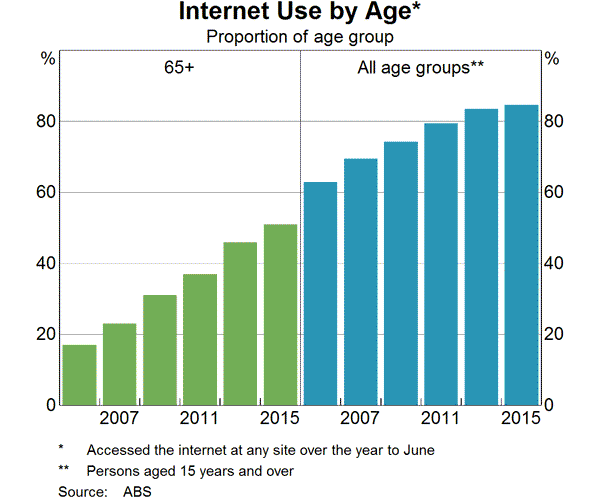
We will get a further reading on households' use of cheques and other payment instruments in the Bank's next Consumer Use Survey, which – if we follow the timetable of recent surveys – will be published in the first half of next year based on data collected late this year.
More broadly, as the industry starts to think about options for the cheque system, it will be important to make sure that those parts of the community that still use cheques are fully consulted so that we can be sure that their payment needs are met by other instruments. This is likely to involve consultations with organisations representing older age groups, the non-profit sector and those in rural Australia.
Cash
Discussions about the declining use of cheques sometimes also touch upon the declining use of cash.
Because transactions involving cash typically do not involve a financial institution, data for the use of cash are actually quite limited. However, one good source of data on the use of cash by individuals is the Bank's Consumer Use Study. Our most recent study, in late 2013, showed that cash remained the most important payment method for low-value transactions (around 70 per cent of payments under $20). However, it confirmed that the use of cash had declined significantly, with the proportion of all transactions involving cash falling from 70 per cent in the 2007 survey to 47 per cent in 2013.
More recent data on the transactions use of cash are not available, though the ongoing fall in cash withdrawals from ATMs and at the point of sale suggest that it has continued. In addition, the continuing strong growth of contactless transactions and the growing acceptance of cards for low-value transactions are also suggestive of a further decline in the use of cash.
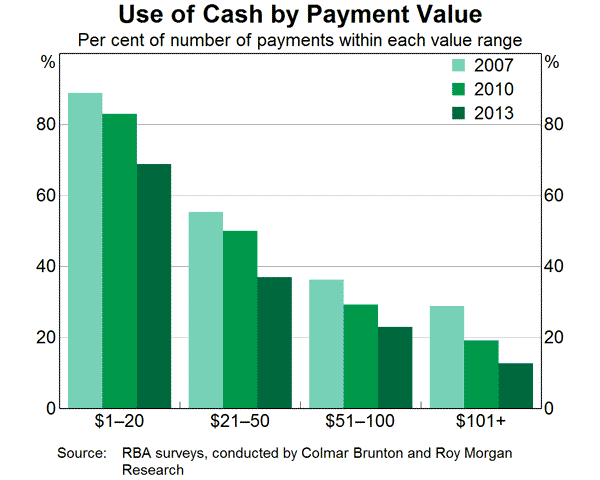
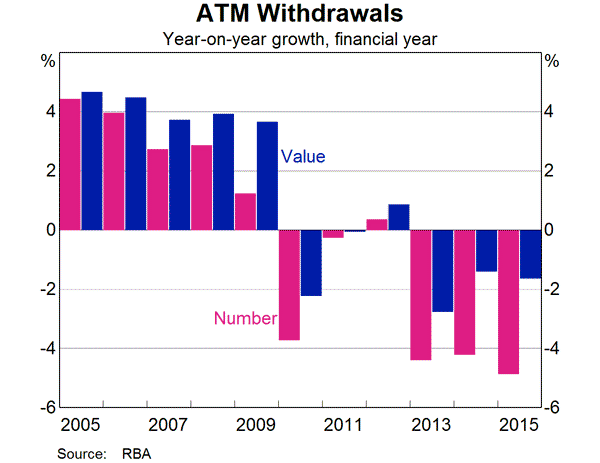
However, that is where the parallels with cheque usage end. While the use of cash in transactions has been declining, the demand to hold cash has continued to grow. This is the case for low denomination banknotes as well as high denomination ones. Indeed, in recent years there has been a modest increase in the rate of growth of banknotes on issue, to an annual rate of around 7 per cent over the past couple of years. More broadly, over the longer term, growth in banknote holdings has been largely in line with nominal growth in the overall economy.

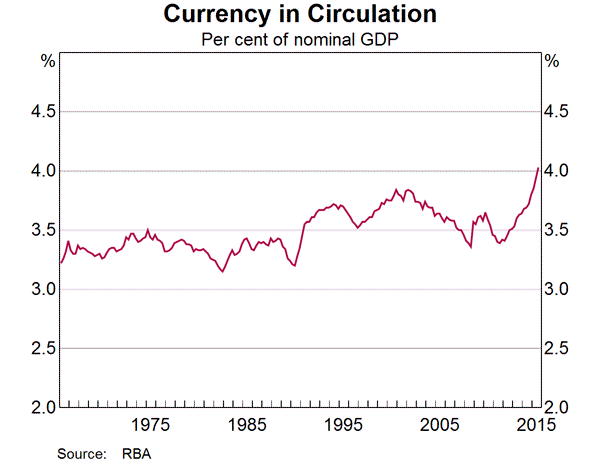
The growing demand for holdings of cash suggest that it continues to have an important role as a store of value and there is some evidence – from demand for larger denomination notes – that this increased following the global financial crisis. So, despite the decline in use in transactions, cash is likely to remain an important part of both the payments system and the economy more broadly for the foreseeable future. In particular, significant parts of the population appear to remain more comfortable with cash than with other payment methods in terms of ease of use for transactions or transfers, as a backup when electronic payment methods may not be available, or as an aide for household budgeting.
Given the important ongoing role of cash in the payments system, the Bank is currently undertaking a major project to upgrade the existing stock of notes. Counterfeiting rates of the current series of banknotes remain low by international standards but have been rising and there are some signs that the counterfeiters are getting a bit better with new and cheaper scanning, printing and image manipulation technology. Accordingly, the program for the next generation of banknotes includes major security upgrades that should ensure that Australia's banknotes remain some of the world's most secure. The first release of the new banknotes will occur in September this year, with the release of the new five dollar note.
Australia is not alone in continuing to invest to ensure that the public can continue to have confidence in its banknotes. The United States has also done so recently, and Sweden – which is often cited as being furthest along the path to a cashless or less-cash society – is also in midst of introducing a new series of notes.
Digital currencies and distributed ledgers
As the use of cash and cheques continues to fall, the Bank will – subject to there not being any overriding concerns about risk – be agnostic as to what payment methods replace the legacy systems, consistent with its mandate to promote competition and efficiency.
In the short run, it is likely that we will see further growth in the existing electronic payment methods, including payment cards in their various form factors. In the medium term, it is likely that we will see growth in new payment methods and systems, including those that will be enabled by the NPP.
Let me stress that the Bank has not reached a stage where it is actively considering this, but in the more distant future it is even possible that we may we see a digital version of the Australian dollar. As the Bank has noted in the past, it seems improbable that privately-established virtual currencies like Bitcoin, with its significant price volatility, could ever displace well-established, low-inflation national currencies in terms of usage within individual economies. Bitcoin has, however, served to stimulate interest in the potential offered by distributed ledgers, extending to the possibility of central-bank-issued digital currencies. A plausible model would be that issuance would be by the central bank, with distribution and transaction verification by authorised entities (which might or might not include existing financial institutions). The digital currency would presumably circulate in parallel (and at par) with banknotes and other existing forms of the national currency.
A few countries have explicitly discussed the possibility of digital versions of their existing currency. Both the Bank of England and Bank of Canada have indicated that they are undertaking research in this area. And a recent announcement from the People's Bank of China indicated that it has plans for digital currency issuance, though few specifics were provided.
The Bank will be interested to see what proves to be possible and what proves to be problematic, as countries consider going down the path of digital currency issuance. Given the various cybersecurity and cryptography risks involved, my personal expectation is that full-scale issuance of digital currency in any country, as opposed to limited trials, is still some time away. And I think it remains to be seen if there is real demand for a digital equivalent of cash and what it might offer end-users relative to what will be offered by the various forms of real-time payments that are being developed in many countries through projects like the NPP.
I should also touch briefly on another potential application of blockchain or distributed ledger technologies, namely in the settlement of equity market transactions. As the overseer of clearing and settlement facilities licensed to operate in Australia, the Bank obviously has a keen interest in the plans of the ASX Group to explore the use of distributed ledgers. Along with the Australian Securities and Investments Commission and other relevant public sector organisations, we will be working closely with ASX as it considers whether a distributed ledger solution might be the best way to replace its existing CHESS infrastructure.
Review of Card Payments Regulation
I will conclude with a few comments on the ongoing Review of Card Payments Regulation.
The Bank issued a consultation paper containing some draft changes to standards in late 2015. It has received substantive submissions from 43 different stakeholders, with a number of parties providing both a public submission and additional confidential information. 33 non-confidential submissions have been published on the Bank's website.
The submissions indicate that most end-users of the payments system are broadly supportive of the Bank's reforms over the past decade or more. Some submissions have indeed suggested that the Bank could have gone further in its proposed regulatory changes. Financial institutions and payment schemes have expressed a range of views. For the most part they have recognised the policy concerns that the Bank is responding to. In some cases there is a fair bit of common ground in areas where they have made suggestions for changes to the draft standards, but in others there are conflicting positions that correspond to the different business models of the entities that have responded to consultation.
The Payments System Board discussed the Review at its meeting last Friday, focusing on issues that stakeholders have highlighted in submissions. As we always do when regulatory changes are proposed, Bank staff will be meeting with a wide range of stakeholders to discuss submissions. Indeed, we have already had a significant number of meetings, sometimes multiple meetings with particular firms as they were preparing their submissions.
Some of the issues to be explored in consultation meetings include: the treatment of commercial cards and domestic transactions on foreign-issued cards in the interchange benchmarks; the proposed shift to more frequent compliance to ensure that average interchange rates remain consistent with benchmarks; and the calculation of permissible surcharges for merchants (such as travel agents or ticketing agencies) that are subject to significant chargeback risk when they accept credit or debit cards.
One other issue that I would like to flag ahead of our consultation meetings relates to the proposed reforms to surcharging arrangements. The Bank's proposed new surcharging standard has been drafted to be consistent with amendments to the Competition and Consumer Act 2010 which were passed by the House of Representatives on 3 February and by the Senate yesterday.
The proposed framework envisages that merchants will retain the right to surcharge for expensive payment methods. However, the permitted surcharge will be defined more narrowly as covering only the merchant service fee and other fees paid to the merchant's bank or other payments service provider. Acquirers would be required to provide merchants with easy-to-understand information on their cost of acceptance for each payment method, with debit/prepaid and credit cards separately identified. The draft standard would require that merchants would receive an annual statement on their payment costs which they could use in setting any surcharge for the following year. The information in these statements should allow the Australian Competition and Consumer Commission (ACCC) to easily investigate whether a merchant is surcharging excessively.
The objectives of the proposed changes to the regulation of surcharging received widespread support in submissions. However, a number of financial institutions have argued that it would be difficult to provide statements to merchants on their average acceptance costs for each payment system. Some have said that their billing process draws on multiple systems within their organisations (and sometimes from third parties), so that it is not straightforward to provide the average cost information proposed by the Bank. Some have indicated that they do not currently provide annual statements to merchants, so this would be a significant change. Accordingly, a number have suggested that they would prefer a significant implementation delay before they are required to provide merchants with the desired transparency of payment costs. Bank staff will be testing these points in our consultation meetings with acquirers. In doing so, we will be looking to see what might be done to ensure that the standards can take effect as soon as possible, in order to meet community expectations about the elimination of instances of excessive surcharging.
More broadly, the Board also discussed a possible timeline for concluding the Review. The Bank's expectation is that a final decision on any regulatory changes should be possible at the May meeting. It is too soon to give much guidance on the date when any changes to the Bank's standards might take effect, but the Board recognises that an implementation period will be necessary for the industry.
Conclusion
Clearly there is a lot happening in the Australian payments sphere, both in terms of the front-end services that end-users will see and the back-end infrastructure that allows it all to happen. There may have been times in the past when payments did not appear particularly interesting but that is certainly not the case right now. I would now be happy to respond to any questions.
Endnotes
I am grateful to Ed Tellez who has contributed to the analytical work for this talk. [*]
